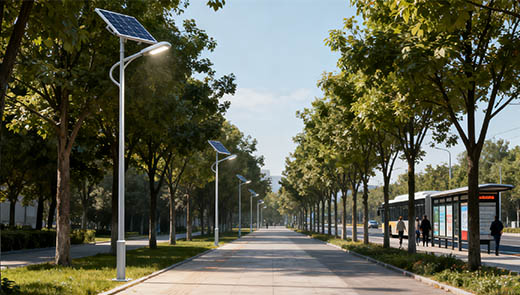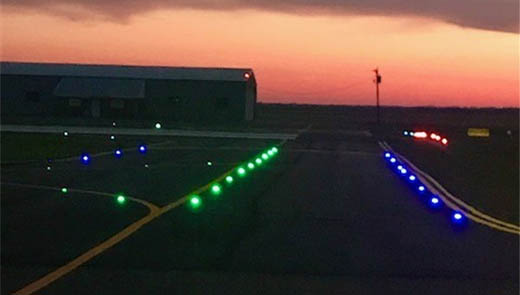How Weather Conditions Affect Street Lighting Performance
In modern urban life, street lighting is more than just a light to illuminate the night; it is a key element in maintaining public safety and the efficient operation of cities. From keeping pedestrians and vehicles safe to deterring criminal behavior, the importance of street lighting cannot be overstated. However, complex and changing weather conditions, but as a latent “invisible opponent”, continued to test the performance and stability of street lighting. An in-depth investigation into the impact of weather factors on street lighting and how to effectively respond to them is of great significance in improving the quality of urban lighting and the safety of residents' lives.
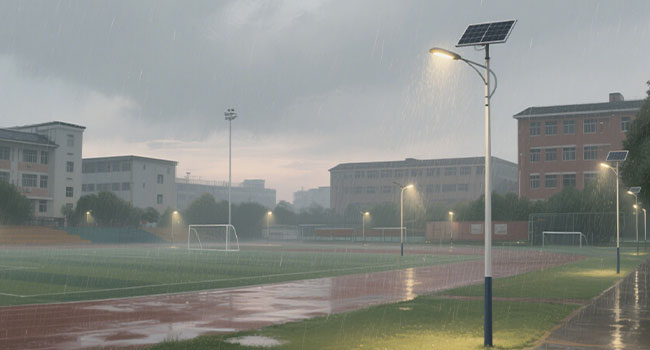
The Importance of Street Lighting
A Solid Barrier to Public Safety
Good street lighting is an important guarantee to reduce the risk of accidents. Whether you are traveling at night or experiencing inclement weather such as rain or snow, sufficient bright light allows pedestrians, drivers and cyclists to see the surrounding road conditions more clearly. For example, at night, street lights illuminate the road so that pedestrians can clearly see potholes and obstacles on the road, and drivers can spot pedestrians or vehicles that suddenly appear in time, thus giving them more time to react and avoiding collisions. In rainy and snowy weather, visibility is greatly reduced, the light from street lights penetrates the rain, fog or snow to maintain a clear line of sight for people's safety on the road.
At the same time, bright streets are a powerful weapon against crime. The high visibility of the environment makes it difficult to hide unlawful acts, potential criminals will be afraid of being found and give up the crime, thus enhancing the residents' sense of security in the night travel, and play a positive role in maintaining community security.
The Right Hand of Traffic Management
Street lighting is also indispensable for the optimization of traffic management. Bright and clear roads and intersections help drivers quickly and accurately recognize traffic signals, road markings, and surrounding vehicles. For example, at intersections, bright lighting allows drivers to see the traffic light status from a distance, to slow down or accelerate in advance, avoiding the red light or emergency braking caused by poor visibility, making traffic flow smoother and effectively reducing traffic congestion.
When drivers are able to predict the route according to the visible road conditions and reasonably adjust the speed, not only can shorten the overall travel time, but also reduce the incidence of traffic accidents caused by poor communication or unknown road conditions. From a macro perspective, street lighting is an important part of building a safe, convenient and livable urban transportation network.
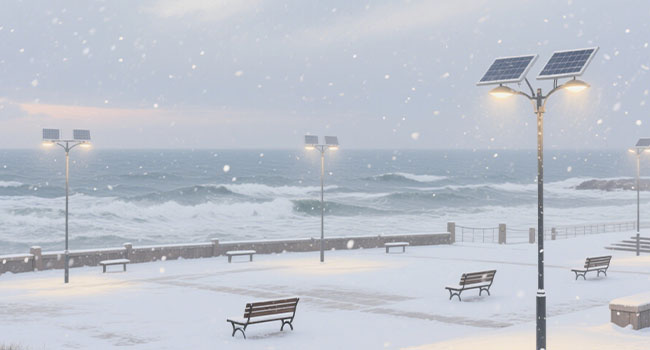
Impact of Various Weather Conditions on Street Lighting
High Temperatures
In desert areas or hot cities in the summer, temperatures often reach over 50°C (122°F). Such high temperatures affect the batteries, solar panels and LEDs in street lights. Traditional lead-acid batteries experience accelerated internal chemical reactions at high temperatures, aging of the plates and evaporation of the electrolyte, resulting in a rapid decline in capacity and a shortened lifespan. Lithium batteries are chemically stable, good heat resistance, can maintain stable charging and discharging efficiency at high temperatures, and are the preferred choice for solar street lights in high temperature areas.
Elevated temperature will reduce the conversion efficiency of solar panels. For every 1°C rise, the conversion efficiency decreases by 0.4% - 0.5%. Reasonable ventilation design can help dissipate heat and reduce the impact of high temperature. If the heat generated from operation is not emitted in time, it will increase the chip temperature, resulting in lower luminous efficiency, increased light decay, and shorter lifespan of the LED light.
Heavy Rain and Flooding
In monsoon areas, coastal areas and cities with frequent rainfall, street lights are challenged by heavy rain and flooding. street lights in these areas need to be IP66 rated and above to prevent dust ingress and rain damage. But waterproofing is not enough. Wet conditions can cause metal parts to rust and corrode, reducing structural strength. In flood-prone areas, install batteries in high places or use waterproof battery boxes to avoid water damage.
Snow and Freezing Conditions
Snow and freezing temperatures are a problem for street lights in cold regions. Snow covers the solar panels and prevents them from absorbing solar energy, resulting in insufficient power supply for street lights. This can be solved by adjusting the angle of the solar panels, using self-cleaning coatings, or sweeping by hand. Low temperatures reduce battery discharge capacity. While ordinary lead-acid batteries may lose 30% - 50% of their capacity at low temperatures, lithium iron phosphate batteries can operate normally at -40°C, guaranteeing power supply for street lights in winter.
Strong Winds and Storms
Hurricanes and typhoons are common in areas where street light structures are put to the test. Strong winds create thrust and torque on street lights, and unstable street lights may be blown over. Tapered poles with wind-resistant designs reduce wind resistance, and reinforced mounting bases and fittings increase stability. In addition, debris from storms can impact luminaires. Using shatter-resistant glass and impact-resistant materials for luminaires reduces damage and ensures that street lights are restored to light as soon as possible after a storm.
The Role of Smart Technologies in Adapting to Weather Changes
As technology continues to evolve, the emergence of smart lighting technologies offers new and effective ways to address the challenges of weather changes on street lights.
Light Adjustment Features
Intelligent street lights with built-in sensors are like having a “smart brain” that can keenly sense changes in the environment and automatically adjust the brightness according to the actual situation. In foggy weather, visibility is extremely low, the light sensor of the smart street light detects the dimming of the ambient light, and will immediately and automatically increase the brightness to provide sufficient lighting for the road to ensure that vehicles and pedestrians can see the road ahead, to protect travel safety. On a clear night, especially when the moonlight is bright, the surrounding environment itself has a certain brightness, the intelligent street light will automatically reduce the brightness, in order to meet the basic lighting needs at the same time, effectively save energy.
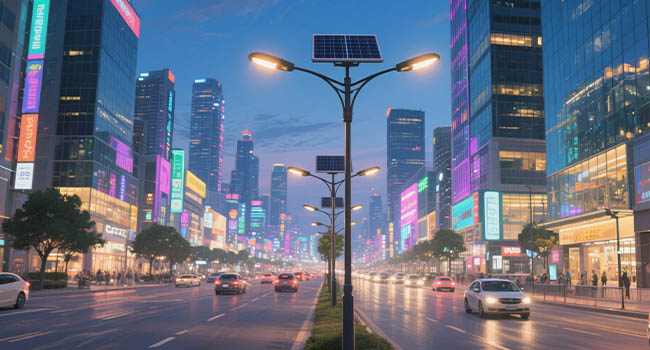
This flexible adjustment not only ensures safe lighting in different weather and environment, but also realizes the optimal use of energy. Compared with traditional street lights, intelligent street lights have obvious advantages in energy saving and can save a lot of power resources for the city.
Maintenance Alerts
Various sensors in the intelligent street light system can not only sense the ambient light, but also monitor the operation status of the street light in real time. Once potential problems such as water ingress, high temperatures, or abnormal battery power are detected, the sensors will immediately send an alert to the maintenance staff. For example, when a street light is subjected to heavy rain and a small amount of rainwater seeps into the interior of the luminaire, the humidity sensor will quickly detect the change in humidity and feed the information back to the control system, which will then send out an alert to notify the maintenance staff to deal with the problem in a timely manner, avoiding damage to the circuitry due to the accumulation of water.
This proactive maintenance model allows problems to be detected and resolved in a timely manner before they become serious malfunctions or costly repairs, greatly improving the reliability and service life of the street lights and reducing the maintenance costs of the city's lighting system.
Best Practices in Implementing Adaptive Street Lighting
There are a number of scientifically sound best practices that need to be followed in order to create an efficient adaptive street lighting system that is better able to cope with all weather challenges.
Strategic Planning and Assessment
Before introducing adaptive lighting technology, city planners need to conduct a thorough and in-depth assessment of the existing lighting infrastructure and local climate conditions. First, through field research and data analysis, it is important to identify areas that have special lighting needs due to frequent inclement weather. For example, roads in coastal areas need to focus on the impact of strong winds and heavy rains on street lights; in alpine areas, low temperatures and snow accumulation should be a concern. Secondly, the energy consumption and efficiency of the existing street lights are analyzed in detail to understand the deficiencies of the current lighting system, which will provide an accurate basis for the subsequent technology selection and program design.
Choosing the Right Technology
According to the local climate characteristics and actual needs, it is crucial to select a lighting system with strong environmental sensing ability and dynamic adjustment function. In terms of technology selection, priority should be given to long-life, fast and efficient LED lights, which can quickly respond to changes in the environment and realize precise adjustment of brightness. At the same time, smart street light systems equipped with high-precision sensors that can accurately sense light, temperature, humidity, wind speed and other environmental parameters should be selected to ensure that street lights can operate stably under different weather conditions and provide reliable lighting services for the city.
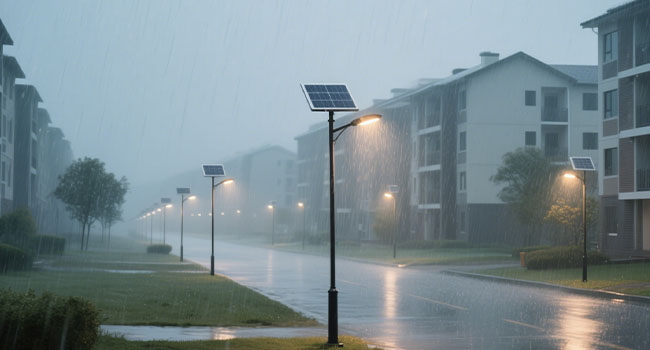
Integration with Smart City Systems
Integration of the adaptive street lighting system with the smart city framework is the key to its effectiveness. Through the network, the street lighting system collects environmental and operational data in real time and transmits it to the management center, where managers can scientifically adjust lighting strategies, such as enhancing perimeter lighting before major events. At the same time, the integration of the system promotes the collaboration of municipal departments. In case of inclement weather, the lighting, transportation, and emergency departments can share information and jointly formulate response plans to enhance the overall management and emergency response capability of the city.
Community Engagement and Feedback
We actively interact with community residents and collect their feedback on the new lighting system through questionnaires, open forums or online platforms. Residents' opinions will help to further optimize the lighting scheme and ensure that the system meets the public's needs and expectations.
Ongoing Monitoring and Maintenance
Establishing a regular inspection and maintenance mechanism to monitor the street lighting system on a regular basis is the key to ensuring its stable operation. A hierarchical inspection program can be established, such as checking the appearance of lights and lanterns, wiring connections and brightness every month, testing the battery capacity and solar panel efficiency every quarter, and conducting a comprehensive system evaluation every year. With the help of intelligent monitoring system real-time warning abnormalities, the maintenance team responds in time to replace aging parts and repair potential failures, effectively reducing the risk of failure and ensuring continuous and stable street lighting.
The impact of weather conditions on street light performance is multidimensional and complex, from high temperatures and torrential rain to severe cold and strong winds, each of which presents unique challenges to street light systems. However, with the continuous development of intelligent lighting technology, combined with scientific and reasonable implementation strategies, future street light systems will be smarter, more efficient, and more reliable, able to continue to escort the safe and efficient operation of the city under changing weather conditions, and create a safer and more comfortable nighttime living environment for residents.


